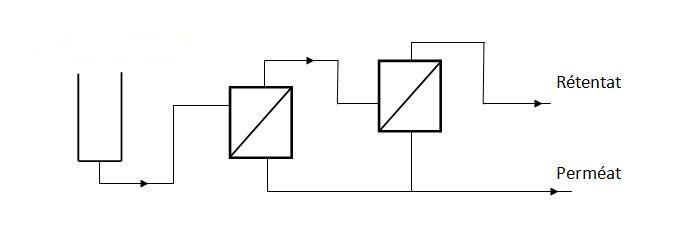Carter : enclosure in which the membranes are assembled and joined to allow the fluid to separate into permeat and retentat. It is tubular, in stainless steel or plastic with connections.
Clogging: (see Soiling)
Concentrat : (see Retentat)
Dalton : A mass unit of atoms (Da). A Dalton is, with fairly good precision, the mass of a hydrogen atom. Its exact value is 1.00794 uma (uma: unified mass unit of atoms). Dalton or Kilo Dalton is often used to indicate the cutoff threshold of a membrane separating very small molecules.
flow : volume measurement per unit of time (m3/h or l/h)
Flow rate with water : flow of clean water, expressed in l/h/m², achieved under standardized conditions of temperature and pressure, to check the state of cleanliness of the membranes.
Reverse flow declogging (Back Pulse): Permeat reverse flow under pressure, during a short sequence (a few seconds), periodically performed during production to maintain filtration performance.
Diafiltration : A process that uses retentat dilution to improve separation performance.
Pore diameter : expresses the size of the orifices of the membrane filter layer through which the permeat will pass. Generally expressed in nanometer or micrometer.
Pressure difference (DP): the difference between the average working pressure and the permeat outlet pressure (in bar).
Soiling : a phenomenon that results in the decrease of fluxes passing through the membrane (with constant parameters). In general, due to a pore-occluding of the membrane either at the surface or at depth. Regular cleaning of the membranes helps to fight against soiling phenomena.
Floor : Filtration loop including modules, pumps, instrumentation, and hydraulic circuits. An industrial installation may have one or more floors.
Volumetric concentration factor FCV: ratio of the initial volume to be processed with the final volume of the retentat.
Filtrat : see Permeat
Tangential filtration : describes the filtration mode used when the fluid to be processed circulates parallel to the membrane separation layer in order to limit the clogging phenomenon of the membrane and to maintain the efficiency of the separation process .
Flow : volume measurement per unit area of membrane and time (l/h/m²)
Membrane : a selective barrier that filters liquids by retaining particles or molecules of molecular size and molecular weight greater than the pore diameter
Mineral or inorganic membranes : membranes consisting of a macroporous support providing mechanical resistance, on which is applied one or more filtering layers made from metal oxides, glass or carbon, find their (s) application (s) in the fields of MF, UF and NF.
Organic membranes : Membranes made from organic materials: cellulose acetate, polysulfone, polyethersulfone, polyamide, polymer alloy. They find their application in the fields of MF, UF, NF and OI.
Microfiltration : membrane separation technique, implemented when the size of the particles or molecules to be separated is between 2 and 0.1 μm.
Module : A set of membranes, seals, and cases.
Nanofiltration : Membrane separation technique, implemented when the size of the particles or molecules to be separated is between 0.01 μm and 0.001 μm.
Cleaning : A procedure implemented in tangential filtration processes to help restore membrane performance.
Cleaning in place (NEP): design elements of the facility that make it possible to have on the facility means for carrying out the cleaning.
Osmosat : see Permeat.
Reverse osmosis : Membrane separation technique, implemented when the size of the particles or molecules to be separated is below 0.0001 μm.
Permeability : see Flows
Permeat : fluid that contains substances that are diffused through the membrane.
Porosity : See Pore Diameter
Work pressure : pressure applied to the liquid to be processed (in bar). This pressure can vary from 1 to 80 bar depending on the applications.
Process de type continu :
Transmembrane pressure (PTM): Differential pressure between the retentat side and the permeat side. The average PTM is the average of the inlet pressure and outlet of fluid to be processed on the retentat side, minus the permeat outlet pressure.
PTM = ((Inlet pressure + Outlet Pressure) / 2) – Permeat Pressure
Continuous type process :

Batch type process :

Batch process powered :

Retentat : fluid that contains the substances retained by the membrane.
Backwashing (Back Flush): Filtration flow returned counter-current through the membrane to loosen the clogging material from the membrane surface, then swept by the tangential current.
Cutoff threshold : value, expressed in Dalton, KDalton, nanometer or micrometer, which indicates for a membrane, under normal conditions, the size of the particles or molecules that will be retained by the filter layer.
Fluid Temperature : A factor influencing the performance of tangential filtration techniques, this parameter modifies the viscosity and flow of fluids at the surface and across the membrane.
Ultrafiltration : Membrane separation technique, implemented when the size of the particles or molecules to be separated is between 0.1 μm and 0.01 μm.
Circulation speed : volume measurement per unit passage section and time unit (m /s) which refers to the average speed of the fluid flowing parallel to the membrane.
Tangential Speed : (see Circulation Speed)
